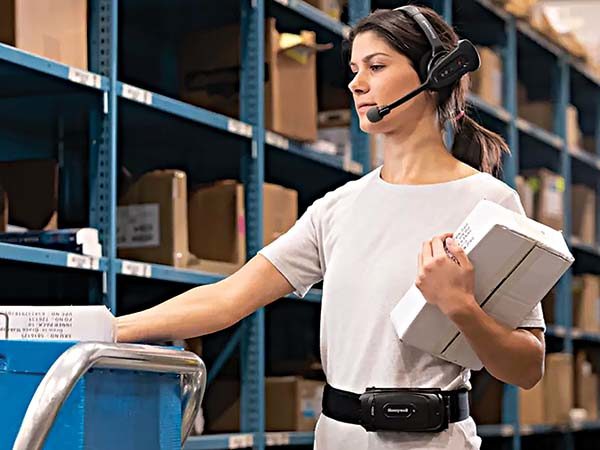Voice technology: It’s not just for picking anymore
Pick-by-voice solutions have been streamlining the picking process in warehouses and distribution centers for years. Now the technology is being applied widely to other workflows, driving even more efficiency in today’s fast-paced DCs.

Voice-directed picking solutions have been transforming distribution centers (DCs) for years, but today voice technology is being applied beyond picking to yield even greater efficiencies within the four walls of the DC. It’s not uncommon for companies to use voice-based solutions for receiving, cycle counting, packing and loading, and more these days—and experts say interest is growing as DCs struggle to find enough workers to handle ever-higher order volumes.
“In the past few years, there has been more interest in automating additional workflows in the warehouse using voice,” explains Keith Phillips, president and CEO of voice-technology solutions provider Voxware. “We started [using] voice for other processes in the warehouse back in 2015. Adoption was relatively slow back then, but as we’ve gone forward and come out of the pandemic, the demand on distribution operations has increased significantly … [so] everyone has been looking for ways to gain more efficiency.”
And they’re turning to voice because of its solid track record in the warehouse and DC. The experts say pick-by-voice solutions are easy to deploy, cut picking time, and improve accuracy by audibly directing pickers to the correct bin, shelf, or aisle along the optimal pick path. The hands-free, eyes-free solution allows pickers to focus on visually locating and selecting the correct item; there are no paper-based lists to refer to or written instructions to follow. A device—most commonly a headset or dedicated terminal—guides the worker through the entire process.
Those attributes, combined with an increasingly advanced technology landscape, make voice a prime candidate for automating all those other workflows as well.
“Today, people want to use voice the way they want to use voice,” explains Bob Bova, president and CEO of voice automation technology company AccuSpeechMobile. “It is a mature technology, but what customers expect now is completely different from what they expected in 2010.”
BEYOND PICKING
Technology advances are a big part of why voice has become so ubiquitous. Today, most voice-based technology systems are user-independent, meaning that workers don’t have to spend time training the system to recognize their voice before getting to work. New users can be up and running with the technology in minutes simply by listening to instructions and responding with a spoken confirmation or commands. Natural language processing—which allows computers to understand text and spoken words in much the same way that humans do—has enabled those advances.
And although the use of voice in the warehouse has moved beyond picking, it almost always is introduced there first. Bova says voice-directed picking is the highest-density application in most warehouses and DCs, and that many of AccuSpeechMobile’s clients ask about expanding it to other workflows after they’ve experienced improvements in picking speed and accuracy. He says common expansion areas include receiving, packing, shipping, putaway, cycle counting, replenishment, and restocking.
Indeed, today’s voice-picking solutions are part of a much broader category that is frequently referred to as “voice-enabled workflow management.” And the shift has been happening over time, as Phillips and others have pointed out. A 2020 white paper from Honeywell Voice, a division of industrial systems company Honeywell, refers to the technology as a “robust solution that consistently delivers business results in multiple workflows in a wide variety of essential DC processes and workflows.” Voice tech is a central element of the company’s “guided work solutions” business, which brings together voice software, hardware, support, and enablement tools in one platform.
And in every application, better productivity and accuracy are the ultimate end goals.
“All customers work very hard optimizing applications [and] workflows, as they are constantly trying to find any strategy that can increase productivity and eliminate errors,” Bova says, adding that AccuSpeechMobile’s device-based approach makes it easy for customers to test new workflows before rolling them out in the DC; there are no servers or middleware involved in the application, and no need to make changes to a company’s back-end system before applying the technology to a new process. “Some applications show a big leap; others are more modest. The critical factor here is that since we make it easy to try it, customers can leverage voice automation in any application they feel might benefit. This empowers operations managers to test the project on a device or two and get user feedback.”
A case in point: AccuSpeechMobile customer Cabela’s, an outfitter and sporting goods chain, has voice-enabled workflows across a handful of national DCs and 70 retail stores. The system is being used on a range of hardware platforms to coordinate workflows for the company’s omnichannel distribution operations. Cabela’s voice-enabled workflows include picking, cycle counting, packing, put-to-store, shipping, pick-to-replenishment, receiving, retail operations, cross-docking, and inventory auditing. In a published case study about the project, the company points to double-digit productivity and error-reduction improvements as a result of those implementations.
“The scope of voice deployment is across all four of our distribution centers and across every one of our 70 retail stores,” according to Cabela’s spokesperson Brent Glassmaker. “With each process, we achieved new benefits and improvements every time.”
BUILDING PALLETS, CARTONS
Voice technology can also help companies improve the way they prepare orders for delivery. Phillips points to recent customer projects that have voice-enabled pallet and carton building as examples. Voxware created a software solution within its Voice Management Suite (VMS) that directs workers through the warehouse based on where items should be placed in a carton, tote, or pallet for optimal shipping and delivery. When putting together a pick assignment, the VMS accounts for each product’s weight and dimensions in determining the right container and pick path for the order.
“The system will look at the assignment, pull in the dimensions and weight information, and tell the selector what size carton to put on their cart to go through for picking—so that items go [into the container] in the correct order,” Phillips explains. “It’s a highly configurable solution, and it’s something that’s been really valuable to customers.”
One automotive industry customer is using the solution for carton building, and a food industry customer is using it to build pallets. In both cases, higher productivity and greater accuracy are the primary results. Phillips says, on average, most voice-enabled operations will lead to a 30% increase in productivity and 99.99% accuracy.
Those results are helping to propel voice technology even further: A 2023 market research report from Fortune Business Insights forecasts a nearly 25% compound annual growth rate (CAGR) in the global speech and voice technology market over the next seven years, rising to a value of nearly $60 billion in 2030 from roughly $13 billion this year. The report doesn’t track growth in warehousing and logistics specifically, but it did find that retail and e-commerce are some of the largest users of the technology.
Phillips and Bova likewise see warehouse operations as a market ripe for growth.
“Nobody tracks adoption of voice in the [warehousing and logistics] marketplace, but there are still a ton of companies that are picking on paper—and a lot of them are not small companies,” Phillips says. “We’re working with several right now that have multiple warehouses [and] hundreds of selectors, and they’re picking on paper. There is definitely a lot of room for expansion in the voice market.”
For Bova, it’s the increasingly complex nature of supply chains that is making the biggest difference in the adoption of voice-enabled technology.
“I really think that the folks that are on the front lines, [who are dealing with] the complexity and the diversification of the supply chain in general, are handling what might be the most difficult part of any company’s business today,” he says. “It really is a wonderful feeling for us when we can show customers how [voice technology] works—and that they can use it how they want to use it. The whole idea is to take some pressure off those guys [in warehousing and supply chain].”
Riding the high-tech wave
Voice-based technology is part of a larger wave of automation that is transforming warehouse operations—and it’s a trend that’s here to stay.
Warehouse optimization software developer and voice technology provider Lucas Systems put some data behind all the claims about the benefits of automation in a 2022 survey titled Voice of the Warehouse Worker. The survey polled 500 U.S. on-floor warehouse workers about their experiences, expectations, and perceptions of technology tools—everything from voice-directed solutions to robotics—and found that most employees would take a pay cut and switch jobs to use technology that will help them do their jobs better. By the numbers, the survey found that:
- Nearly three-quarters of on-floor workers said they would consider a pay cut at another company for an opportunity to use technology that would help them in their job.
- Three-quarters said physical strain in their jobs takes a bigger toll on them than mental strain; the leading cause of physical strain is carrying and/or lifting followed by walking and/or traveling.
- Top causes of mental strain include meeting performance or incentive goals and objectives (25%) and safely maneuvering around the warehouse (20%).
- Workers see robots as productive allies but fear increased quotas. Still, more than two in five said robots will reduce physical stress (46%) or help them achieve better speed in item picking (44%) or better accuracy (40%).
- Workers said they perceive their company’s technology as an investment in them.
Related Articles

Copyright ©2024. All Rights ReservedDesign, CMS, Hosting & Web Development :: ePublishing